Lives of a Mole Rat
With their huge teeth, squinty eyes, piglike noses, and, in some cases, wrinkled, nearly hairless bodies, mole rats aren't exactly cute and cuddly. The pesky rodents also steal food from farmers.
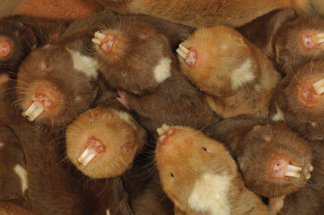
Damaraland mole rats dig tunnels by biting away the soil with large front teeth that arise outside their mouths. A digger can thus keep its mouth closed and dirtfree.
Photo by Tim Jackson
Scientists who study mole rats, however, are smitten with the toothy critters, whose bodies, brains, and social lives offer a wealth of possibilities for research.
These animals use their protruding teeth to dig networks of underground tunnels. They live in complex societies, like termites and honeybees do. One species even has do-nothing couch potatoes among its members.
"There are so many interesting things about them, and very little is known," says Nigel Bennett. He's a biologist at the University of Pretoria, South Africa. "For me, they're little goldmines because there's so much to be found out about them."
Social lives
Mole rats are rodents, but they're more closely related to guinea pigs and porcupines than to moles or to rats. They live in Africa, Southeast Asia, and South America. But they're not easy to spot. That's because, Bennett explains, most of their activities take place underground. This is where the mole rats burrow, mate, and eat. Understandably for tunnel dwellers, they live on roots and tubers, such as sweet potatoes and carrots.
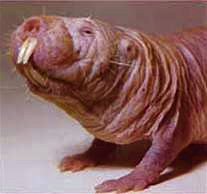
Naked mole rats, which are blind and nearly hairless, live in underground colonies with one queen.
Photo by Jessie Cohen, Smithsonian National Zoological Park.
It's the mole rat lifestyle that first attracted the attention of scientists. Within a colony of as many as 300 members, there's just one queen, and she chooses to mate with only one to three males. In ways that researchers do not yet understand, the queen prevents other females from reproducing.
This kind of social structure, called eusocial, is common among bees, wasps, and termites. Mole rats are the only mammals known to live this way.
Couch potatoes
Among naked mole rats, a eusocial lifestyle probably developed, in part, because most colony members are closely related. Individual members of a colony don't need to mate to carry on the species when they're related and have lots of genes in common, and individuals are willing to make sacrifices for family.
This theory, however, doesn't explain some of the mole rat's other behavioral quirks. In a species called Damaraland mole rats, for instance, some individuals do a lot of work, while others laze around and do nothing.
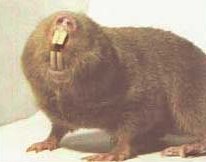
A Damaraland mole rat sniffs the air.
Photo by Jessie Cohen, Smithsonian National Zoological Park.
Researchers have observed that some animals are born into laziness. They don't even have to earn their leisure time.
"It you were working hard all the time, and you saw your sister doing nothing, you'd be quite upset," Bennett says. "Mole rats seem to tolerate it."
In a recent study, Bennett and his team found that active workers, which make up 65 percent of the colony, do 95 percent of the work. Because lazy individuals sit around so much, they're fatter than their hard-working pals.
So why would a group put up with individuals that eat a lot but contribute little? Rain may be the answer. In order for mole rats to dig their tunnels, the soil must be wet and soft. Bennett's group found that lazy mole rats become active after rainfall.
This observation convinced the scientists that the chubby, lazy animals spend most of their time saving up energy so they can tunnel off to mate or to start new colonies when the ground is soft. This role is just as important as working, and the rest of the colony puts up with it because they're all family.
"They're like teenage children," Bennett says. "They eat up all your food and do very little work around the house, but you tolerate them because your genes are there. They're going to go off in the future and produce grandchildren."

Naked mole rats can live a long time. Twenty-one-year-old Cornell University student Dara Neumann holds a mole rat that was born years before she was.
© Cornell University
Brainy teeth
As Bennett and his colleagues learn more about the social lives of mole rats, other scientists are investigating the animals' bodies and brains. Peculiar details are showing up here too.
Ken Catania, a biologist at Vanderbilt University in Nashville, Tenn., works with artists such as Lara Finch to create pictures that illustrate how much of an animal's brain is devoted to each body part. The larger the body part in one of these drawings, the more brainpower the animal directs to it.
Most mammals use lots of brainpower to see, smell, or hear. But mole rats are different. They use most of their brainpower to get feedback from their teeth, Catania says. They use their teeth to feel, dig, and sense the environment.
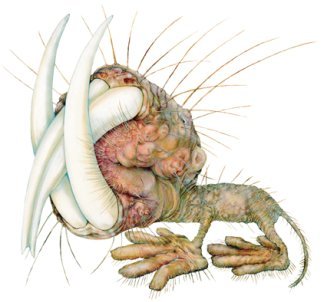
This distorted drawing illustrates how much of a mole rat's brain is devoted to its various body parts. The large size of the teeth shows that much of a mole rat's brain is concerned with getting feedback from the teeth, rather than with hearing, seeing, or smelling. What other body part seems to be important to this animal?
Lana Finch
"The teeth are huge, and that's extremely weird and unusual for an animal's sensory system," Catania says about the "brain's-eye view" illustration (above). "It's the only species we've looked at that has such a huge representation of teeth in the brain."
New research also shows that female mole rats grow in length when they become queens and start having babies. This discovery leads to a list of new questions about how the creatures grow and how individuals change status within a group.
"No other animals I know of change form so dramatically as adults," Catania says.
A second look
If the long list of facts and quirky details doesn't get the love flowing, maybe the words of a veteran mole rat researcher will convince you to give these little creatures a second look.
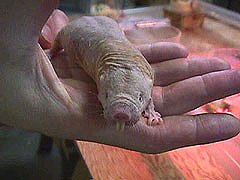
Adult naked mole rats are about 7 centimeters (3 inches) long and weigh 30 to 70 grams (1 to 2.4 ounces).
Photo by Marc Bretzfelder, Smithsonian National Zoological Park.
"Lots of people don't think they're very pretty," says Bennett, who has been studying Damaraland mole rats for 22 years. "You have to spend time with them. They're lovely animals. I think they're beautiful."